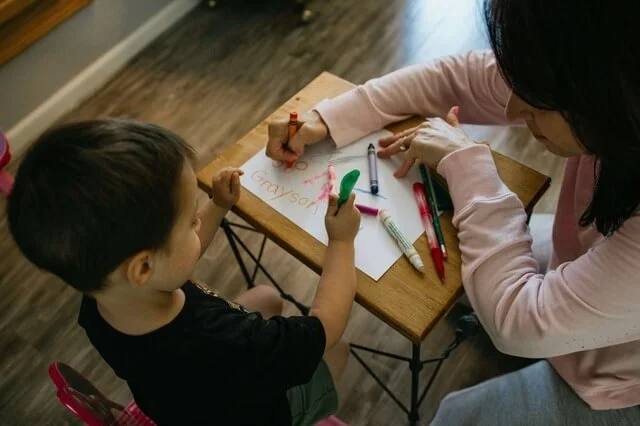What is Reggio Emilia in a daycare setting
Petite Luminaries Childcare’s approach is inspired by the Reggio Emilia approach. Our daycare setting is a child-centered educational philosophy that emphasizes self-directed, experiential learning in a supportive and enriching environment. Originating from the town of Reggio Emilia in Italy, this approach believes children are naturally curious, capable, and driven by a desire to learn. In a daycare setting, Reggio Emilia provides a structure where educators act as co-learners rather than just instructors, guiding children through exploration, expression, and interaction with their environment.
Key Principles of Reggio Emilia in Daycare
- Emergent Curriculum: Teachers design the curriculum based on the interests of the children. Activities and projects evolve from children’s questions, ideas, and interests, fostering a deeper connection to learning.
- Learning Through Play: Play is central to this approach, as it encourages children to express themselves, solve problems, and build social skills. Through play, children explore concepts in math, science, language, and art.
- Environment as the Third Teacher: Reggio classrooms are thoughtfully arranged with natural, open-ended materials that encourage curiosity. The setup is inviting and fosters independence, collaboration, and exploration.
- Documentation: Teachers document children’s work through photos, artwork, and conversations. This process not only tracks progress but also allows children to reflect on their learning journey.
- Collaborative Learning: The Reggio approach emphasizes social interaction, where children work in small groups, share ideas, and build relationships, enhancing social and communication skills.
Benefits of Reggio Emilia in Early Years
- Encourages Independence and Self-Expression: Children take an active role in their learning, making choices that build confidence and autonomy.
- Develops Critical Thinking and Problem-Solving Skills: With hands-on projects and creative play, children learn to think critically, ask questions, and explore solutions.
- Fosters Social and Emotional Growth: Collaboration and expression are core to the approach, helping children develop empathy, cooperation, and resilience.
- Promotes Creativity and Curiosity: Open-ended materials and activities encourage children to express their ideas freely, inspiring creativity and a lifelong love for learning.
Incorporating the Reggio Emilia philosophy into daycare creates a supportive, engaging environment where children feel respected and inspired to learn. This approach not only prepares children for academic learning but also fosters a holistic development that includes emotional, social, and cognitive growth.
In a Reggio Emilia-inspired daycare, materials are carefully chosen to encourage exploration, creativity, and open-ended play. These materials, often referred to as “loose parts,” are versatile, allowing children to use them in various ways and for different purposes. The goal is to inspire curiosity and promote a hands-on, sensory-rich learning experience.
Key Reggio Emilia Materials
- Natural Materials:
- Sticks, stones, leaves, pine cones, shells, and flowers
- Sand, soil, clay, and water
- These elements encourage sensory exploration and foster a connection with nature.
- Loose Parts:
- Objects like wooden blocks, corks, buttons, fabric scraps, beads, ribbons, and cardboard tubes
- Loose parts are versatile and encourage creative construction, sorting, and storytelling.
- Recyclable and Reused Materials:
- Bottle caps, paper rolls, cardboard, old magazines, and glass jars
- These materials are cost-effective and encourage sustainable thinking, while allowing children to reimagine everyday items.
- Art Supplies:
- Non-toxic paints, chalk, colored pencils, clay, and markers
- Varied brushes, sponges, stamps, and natural items like feathers and leaves to create textures
- Art materials are essential in Reggio classrooms, giving children freedom of expression through different mediums.
- Fabric and Textiles:
- Pieces of cloth, yarn, felt, and string
- Used in role-play, constructing soft structures, or creating cozy, aesthetic classroom areas
- Mirrors and Light Tables:
- Mirrors encourage self-reflection, symmetry, and perspective
- Light tables make objects more visible and vibrant, allowing children to explore transparency and layering with different materials.
- Sensory Materials:
- Playdough, sand, rice, and water
- Sensory play encourages fine motor skills, creativity, and an understanding of textures.
- Real-Life Tools and Objects:
- Tools like magnifying glasses, measuring tapes, tweezers, kitchen utensils, and child-safe hammers
- Real-world items build fine motor skills, scientific thinking, and help children make connections to daily life.
These materials create a stimulating and responsive learning environment, fostering a sense of wonder and respect for the natural world and supporting children’s development of creativity, motor skills, and problem-solving abilities.



